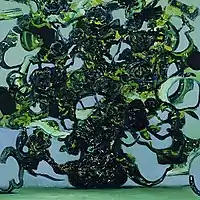Everywhere at the End of Time
Everywhere at the End of Time is a 6-part drone and dark ambient album released from 2016 to 2019 by James Leyland Kirby under the pseudonym of the Caretaker which explores and depicts Alzheimer's disease.
| Everywhere at the End of Time | ||||
|---|---|---|---|---|
 Album art for Stage 6, titled "Necrotomigaud." | ||||
| Recording by | ||||
| Released |
| |||
| Genre | ||||
| Length |
| |||
| Label | V/Vm Test Records | |||
| Producer | James Leyland Kirby | |||
| The Caretaker chronology | ||||
| ||||
The entirety of the sound is created from samples of a wide variety of records and wax cylinders, primarily of ballroom music, ranging from the 1900s to the 1960s. Each of the six albums correlates to one of the six stages an individual goes through while suffering from dementia.[1] The first stage was released in September 2016, with a new installment released every six months before ending with the retirement and canonical death of the Caretaker project on March 14, 2019, when Stage 6 and its companion album Everywhere, an Empty Bliss were released.[2]
In September 2020, the album became an internet phenomenon on websites such as TikTok and Twitter, receiving coverage in publications such as The Quietus and The New York Times.[3][4]
Background
Everywhere at the End of Time was created by James Leyland Kirby under the Caretaker alias, which initially started as a project inspired by The Shining and later used sample-based composition to depict anterograde amnesia, Alzheimer's Disease, and dementia.[5] After the release of An Empty Bliss Beyond This World, which had received significant critical acclaim, Kirby revealed in an interview for Bandcamp Daily that, although he did not express a desire of creating another album for the Caretaker project after An Empty Bliss, the success of it has led to Kirby making an album about the stages of dementia, which was the only thing he could think of. Kirby praises the works William Basinski has done but contrasts The Disintegration Loops to his albums, which are not only about loops breaking down: "They’re about why they’re breaking down, and how."[6]
Music and Albums
Everywhere at the End of Time is divided into six albums, with each representing a decrease in function and capacity of a dementia patient. In an interview with The Believer, Leyland Kirby describes the first three stages as having "subtle but crucial differences, based on the mood and the awareness that a person with the condition would feel", adding that the final three stages "had to be made from the viewpoint of post-awareness". While each composition in the first three stages features a single sample changed through pitch changes, reverberation, looping, crackle and physical degradation, those on the latter three feature multiple samples woven together in a sound collage format which Kirby has likened to John Cage's usage of chance in music.[7] The sound in the later stages is constructed from radical manipulations of samples which had previously appeared in Stages 1–3 or in other Caretaker projects. In making Stages 4 and 5, Kirby claimed that he had over 200 hours worth of music and "compiled it based on mood" using cutting-edge digital technology.[8] Stage 6 consists of drones and dark ambient sounds as well as a choral recording within the last six minutes.
Descriptions of each stage
On the Bandcamp page of the complete edition as well as the YouTube upload,[9] a list of detailed descriptions to each stage accompanies the information about the album. In the series' description, Kirby states that "When work began on this series it was difficult to predict how the music would unravel itself. Dementia is an emotive subject for many and always a subject I have treated with maximum respect."[10]
Stage 1 (A1-B6)

"Here we experience the first signs of memory loss.
This stage is most like a beautiful daydream.
The glory of old age and recollection.
The last of the great days."
Pat Beane from Tiny Mix Tapes noted the "splendor" found in the horn-dominant melody for track A4, "Childishly fresh eyes," combined with the "unsteady" piano presented on track A5, "Slightly Bewildered."[13] Brian Howe from Pitchfork stated that, although the description for Stage 1 suggests "a beautiful daydream," more extreme signs of breakdown are presented later on.[14] As an example, the critic notes the "almost toneless mooing" found on the instrumentals for track A5 or the "inner voice" from track A6, "Things that are beautiful and transient."[14]
Songs from the second half of this stage, such as track B2, "An autumnal equinox," and track B4, "The loves of my entire life," have been described by Howe as possessing "a winning gentleness."[14] However, Howe adds that "by the end, even gentleness has taken on a desperate tinge, as though if the dancing stops, everyone dies."[14] The record ends with, as described by Beane, "melodramatic swells" found on track B6, "My heart will stop in joy."[13]
The only methods of alteration Kirby makes to the samples are adding reverberation and looping sections to create longer pieces, as well as emphasizing the existing vinyl crackle in the mix. In making the first stage, Kirby described the mastering, as done by LUPO,[10] to be "really rich, really big, really consistent sounding all the way through".[15] This stage is often noticed by writers for its generally positive tone[16] and for being "functional, rich and warm" at the same time.[17]
Stage 2 (C1-D5)

"The second stage is the self realisation and awareness that something is wrong with a refusal to accept that. More effort is made to remember so memories can be more long form with a little more deterioration in quality. The overall personal mood is generally lower than the first stage and at a point before confusion starts setting in."
Stage 2 is described as the stage in which "things take a more overtly upsetting turn"[17] and features another usage of "Heartaches" on track C3, "What does it matter how my heart breaks".[19] This stage mainly uses cheerful samples to create tension, such as on track C1, "A losing battle is raging."[20] Track titles from Stage 2 were noticed by some critics for their shift from the uplifting tone from Stage 1, such as "Childishly fresh eyes" and "An autumnal equinox," to the "extremely noticeable" heavy sadness on Stage 2, such as "Surrendering to despair" and "The way ahead feels lonely."[16]
In an interview with The Quietus, Kirby described the "switch" between the first and second album, specifically noting that instead of looping short sections of sampled material as with the first stage, he would let tracks play in full while stripping certain sections away.[15] Many tracks also incorporate echo and static noise to a far higher degree than the first stage, sometimes overtaking the mix to the point where the melody is semi-obscured. This stage has been described by James Catchpole from experimental music website Fluid Radio as "the stage of realisation, of despair, deep grief and feelings of futility."[21]
Stage 3 (E1-F8)

"Here we are presented with some of the last coherent memories before confusion fully rolls in and the grey mists form and fade away. Finest moments have been remembered, the musical flow in places is more confused and tangled. As we progress some singular memories become more disturbed, isolated, broken and distant. These are the last embers of awareness before we enter the post awareness stages."
Stage 3 features the last consistent melody that samples "Heartaches" on track E2, "And heart breaks," and has been described by Beach Sloth from Entropy as the most intriguing of the entire series.[22] Sloth notes a few Stage 3 tracks as some of the Caretaker's best work, from the "bled-dry" jaunt found on track E1, "Back there Benjamin," to the "disorientation" of the confusing melody from track E6, "Sublime beyond loss," a track which Sloth described as Kirby deliberately confusing the sample, making it "impossible to truly focus, letting it become lost."[22] However, Sloth describes the "otherworldly" lullaby of track E8, "Long term dusk glimpses," as the "true heart" of the project, for almost seemingly fighting the memory loss, and failing in doing so.[22]
Stage 3 has been described by Michael Barnett from This Is Darkness as the point where Kirby takes an interesting turn in the project for showing increasing influences of dark ambient music and a decreased focus on melody as it progresses, such as on track F3, "Internal bewildered world." It is the final stage in which samples are recognizable as their original melodies, which become more confused in the second half;[23] track F5, "Aching cavern without lucidity," has been described by Barnett as little more than a "droning murky memory" from what the previous tracks presented. This stage has been described by website No Wave as "The glory of remembrance usurped by panic"[17] and has been noted by Kirby as the most similar to his previous project An Empty Bliss Beyond This World, for featuring many samples which have been taken from the entire project's history.[15]
Post-Awareness Stage 4 (G1-J1)
"Post-Awareness Stage 4 is where serenity and the ability to recall singular memories gives way to confusions and horror. It's the beginning of an eventual process where all memories begin to become more fluid through entanglements, repetition and rupture."
Compared by Miles Bowe from Pitchfork to Oval's critically acclaimed 94 Diskont and to the end of The Shining,[24] Stage 4 marks the beginning of the "Post-Awareness" stages, on which individual tracks are not short and taken from one sample but rather 20 minutes long and featuring changing sections. These stages are often described as scarier, more bewildering,[25] and incredibly disjointed.[26] Several tracks from the Post-Awareness stages occupy whole vinyl sides and are named according to corresponding symptoms of dementia.[25] Bowe described Stage 4 as evolving the Caretaker sound in "often new and frightening ways" and as a record that "makes you feel surrounded, making you a participant rather than an observer."[20]
Tracks G1, H1, and J1—all of them named "Post Awareness Confusions"[20]—consist of distorted snippets of samples taken either from previous stages or from Kirby's previous projects under the Caretaker moniker.[23] As an example, "Goodnight, My Beautiful" by Russ Morgan appears multiple times on this album with distortions that make it almost completely unrecognizable.[20] Music website No Wave has described the first two tracks as the most visceral out of the entire stage, and notes the second one, H1, as having an almost unbearable "stretch of dark, judgement-day horns."[25] These tracks have also been described by Bowe as some of the "darkest, most damaged" noises of the entire series.[20] The record ends with J1, noted by No Wave as "an eerie quiet beginning to descend,"[25] and its abrupt ending being described by Bowe as making the album "even more devastating."[20]
While Bowe states that the "Post Awareness Confusions" tracks reach 'unexplored extremes' for the Caretaker, the 'dreamlike' features of track I1, "Temporary Bliss State," have been noted by the writer for leaving no trace of the ballroom samples that are associated with the series, but rather distorting its unknown source material into "pure ethereal abstraction;" the writer describes it as even more disorienting than any of the "Post Awareness Confusions" tracks, yet being "so beautiful it barely sounds like the Caretaker at all."[20] The track has been described by Michael Barnett from This Is Darkness as giving "a period of solace, a sort of mirage in an endless sea of barren sand dunes,"[23] and by No Wave as "a beautiful reprieve amongst the horror."[25] Barnett states that, while the track is still incredibly disjointed, it is also "quite beautiful, and certainly peaceful in its own way."[23]
Post-Awareness Stage 5 (K1-N1)

"Post-Awareness Stage 5 confusions and horror.
More extreme entanglements, repetition and rupture can give way to
calmer moments. The unfamiliar may sound and feel familiar.
Time is often spent only in the moment leading to isolation."
Stage 5 takes more inspiration from noise music in its usage of samples, which are primarily static noise without melody, with the exceptions of brief moments where clarity is restored. Track titles from this stage are names of specific characteristics of Alzheimer's Disease, such as amyloid plaques, neurofibrillary tangles, and the hypothesis of synapse retrogenesis. It has been described by experimental music publication Fluid Radio as being "some of Kirby's most complex, experimental work."[28]
Post-Awareness Stage 6 (O1-R1)

"Post-Awareness Stage 6 is without description."
Stage 6 consists of drones constructed from vinyl surface noise and severely slowed-down samples which are no longer recognizable to the listener. Track titles from this stage further present the themes of "confusions and horror" which previous stages mentioned, such as "A confusion so thick you forget forgetting" and "A brutal bliss beyond this empty defeat".[29][30]
The final track of the album, "Place in the world fades away", begins with static noise similar to the previous tracks on the album, but eventually shifts to an organ drone before shifting to a recording of a female choir and cutting out suddenly.[31] In Everywhere at the End of Time, this segment has various interpretations: some interpret it as being the phenomenon of terminal lucidity, while others interpret it as the "soul" of the Caretaker being taken to the afterlife.[32][33] The entire record ends with 1 minute of silence, representing the death of the Caretaker character;[34]as usually one minute of silence is mandatory to pay respect for a dead person. This final segment of the album has been described by various commentators and critics as the most emotionally affecting and tragic part of the entire series.[35][36]
Announcement, release, and artwork
The first stage of Everywhere at the End of Time was released on September 22, 2016. Leyland Kirby revealed that he had given the Caretaker project dementia, stating that the project was "a new and finite series exploring dementia, its advance, and its totality...Each stage will reveal new points of loss, progression, and disintegration." He stated that he did not have dementia in an email to Pitchfork.[37] Each subsequent stage was released six months after the previous stage, with the final stage being released in March 2019, after which Kirby claimed that the Caretaker project was no longer active and that he would be moving on to other projects.
Leyland Kirby has acknowledged the political implications of the release schedule of Everywhere at the End of Time in a press release, as the timeline lines up with the process of Brexit. "Both started in 2016 and are due to wrap up in spring 2019. It should be no stretch of the imagination to read into their parallel progression from nostalgia and historic/collective amnesia, to progressive dementia and complete obliteration of (the) sense(s)".[38]
The artwork for Everywhere at the End of Time was created by regular Kirby collaborator Ivan Seal and includes six paintings, one for each stage. An exposition of these paintings by Seal was displayed in the FRAC Auvergne from April 6 to June 16 of 2019 and featured music from Everywhere at the End of Time and Everywhere, an Empty Bliss.[39]
Music videos
A visual representation of the first two stages was created and released by WEIRDCORE.TV, Stage 1 being released the same day as the original release and Stage 2 being released approximately 3 months after the original release. The YouTube upload for the visual representation of the second stage features a different tracklisting.[40][41] As of December 2020, the music videos for the other stages are yet to be released: according to a comment by Kirby on the We Are The Music Makers Forums, while Kirby says that the music videos for the other stages will be happening, the reason they weren't released in line with his releases was because WEIRDCORE.TV was making videos for Aphex Twin, therefore not having enough time to make music videos for Kirby.[42]
Reception
| Review scores | |
|---|---|
| Source | Rating |
| Pitchfork | 7.3 (Stage 1) 7.9 (Stage 4) |
| Tiny Mix Tapes |
|
Everywhere at the End of Time received increased acclaim and critical attention as each subsequent stage was released. In his review of the first stage for Pitchfork, Brian Howe criticized the concept of the record as being "unduly romantic" and claimed that "there is something a little unseemly about Kirby 'giving the project dementia' and reveling in it across hours of pleasurable music."[14] However, Miles Bowe's review of Stage 4 describes it as "the Caretaker's best record since Empty Bliss while evolving its sound in new and often frightening ways."[20] Tiny Mix Tapes reviewed each stage individually, giving the project high acclaim overall and describing Stages 1, 4, and 6 as "defy[ing] categorization and explor[ing] the constructed boundaries between 'music' and 'noise'" and that each stage "is worthy of careful consideration."[13][43][36]
Brian Browne, the president of Dementia Care Education, an organization which trains real caretakers, praised the work for its depiction of the disease, stating that "it's a much welcome thing, because it produces the empathy that's needed" for young people who otherwise would not understand how dementia affects patients.[4]
Everywhere at the End of Time is the best-selling "dark ambient" release on the music website Bandcamp.[44]
Internet phenomenon
Beginning in September 2020, the album became a phenomenon on the popular internet platform TikTok, with videos typically detailing the reactions towards the album as they listen to it over the course of its 6-hour runtime. The full YouTube upload of the album by Kirby's label V/Vm Test has amassed over 6 million views and approximately 100,000 comments as of December 2020.[9]
Leyland Kirby has responded positively to the attention the album series has received, writing that "The fact it's been made into a challenge by some to listen to this work in full, is a reaction to a need for [...] shared experiences".[4]
Track listing
All track listings and lengths adapted from Bandcamp.[10]
| No. | Title | Length |
|---|---|---|
| 1. | "A1 - It's just a burning memory" | 3:32 |
| 2. | "A2 - We don't have many days" | 3:30 |
| 3. | "A3 - Late afternoon drifting" | 3:35 |
| 4. | "A4 - Childishly fresh eyes" | 2:58 |
| 5. | "A5 - Slightly Bewildered" | 2:01 |
| 6. | "A6 - Things that are beautiful and transient" | 4:34 |
| 7. | "B1 - All that follows is true" | 3:31 |
| 8. | "B2 - An autumnal equinox" | 2:46 |
| 9. | "B3 - Quiet internal rebellions" (the V/Vm YouTube upload lists track "Long term dusk glimpses" as this track under the name "Quiet internal rebellions") | 3:30 (Bandcamp) 3:33 (YouTube) |
| 10. | "B4 - The loves of my entire life" | 4:04 |
| 11. | "B5 - Into each others eyes" | 4:36 |
| 12. | "B6 - My heart will stop in joy" | 2:41 |
| Total length: | 41:31 | |
| No. | Title | Length |
|---|---|---|
| 1. | "C1 - A losing battle is raging" | 4:37 |
| 2. | "C2 - Misplaced in time" | 4:42 |
| 3. | "C3 - What does it matter how my heart breaks" | 2:37 |
| 4. | "C4 - Glimpses of hope in trying times" | 4:43 |
| 5. | "C5 - Surrendering to despair" | 5:03 |
| 6. | "D1 - I still feel as though I am me" | 4:07 |
| 7. | "D2 - Quiet dusk coming early" | 3:36 |
| 8. | "D3 - Last moments of pure recall" | 3:52 |
| 9. | "D4 - Denial unravelling" | 4:16 |
| 10. | "D5 - The way ahead feels lonely" | 4:15 |
| Total length: | 41:55 | |
| No. | Title | Length |
|---|---|---|
| 1. | "E1 - Back there Benjamin" | 4:14 |
| 2. | "E2 - And heart breaks" | 4:05 |
| 3. | "E3 - Hidden sea buried deep" | 1:20 |
| 4. | "E4 - Libet's all joyful camaraderie" | 3:12 |
| 5. | "E5 - To the minimal great hidden" | 1:41 |
| 6. | "E6 - Sublime beyond loss" | 2:10 |
| 7. | "E7 - Bewildered in other eyes" | 1:51 |
| 8. | "E8 - Long term dusk glimpses" | 3:33 |
| 9. | "F1 - Gradations of arms length" | 1:31 |
| 10. | "F2 - Drifting time misplaced" | 4:15 |
| 11. | "F3 - Internal bewildered world" | 3:29 |
| 12. | "F4 - Burning despair does ache" | 2:37 |
| 13. | "F5 - Aching cavern without lucidity" | 1:19 |
| 14. | "F6 - An empty bliss beyond this world" | 3:36 |
| 15. | "F7 - Libet delay" | 3:57 |
| 16. | "F8 - Mournful cameraderie" | 2:39 |
| Total length: | 45:36 | |
| No. | Title | Length |
|---|---|---|
| 1. | "G1 - Stage 4 Post-Awareness Confusions" | 22:09 |
| 2. | "H1 - Stage 4 Post-Awareness Confusions" | 21:53 |
| 3. | "I1 - Stage 4 Temporary Bliss State" | 21:01 |
| 4. | "J1 - Stage 4 Post-Awareness Confusions" | 22:16 |
| Total length: | 1:27:21 | |
| No. | Title | Length |
|---|---|---|
| 1. | "K1 - Stage 5 Advanced plaque entanglements" | 22:35 |
| 2. | "L1 - Stage 5 Advanced plaque entanglements" | 22:48 |
| 3. | "M1 - Stage 5 Synapse retrogenesis" | 20:48 |
| 4. | "N1- Stage 5 Sudden time regression into isolation" | 22:08 |
| Total length: | 1:28:21 | |
| No. | Title | Length |
|---|---|---|
| 1. | "O1 - Stage 6 A confusion so thick you forget forgetting" | 21:52 |
| 2. | "P1 - Stage 6 A brutal bliss beyond this empty defeat" | 21:36 |
| 3. | "Q1 - Stage 6 Long decline is over" | 21:09 |
| 4. | "R1 - Stage 6 Place in the World fades away" (Contains 1:00 of silence) | 21:19 |
| Total length: | 1:25:58 | |
References
- Dunn, Parker (26 September 2020). "'Everywhere at the End of Time' Depicts the Horrors of Dementia Through Sound". The Daily Utah Chronicle. Retrieved 23 October 2020.
- "The Quietus | News | The Caretaker Releases Project's Final Stage". The Quietus. Retrieved 3 December 2020.
- "The Quietus | News | 'Everywhere At The End Of Time' Becomes TikTok Challenge". The Quietus. Retrieved 24 October 2020.
- Marcus, Ezra (23 October 2020). "Why Are TikTok Teens Listening to an Album About Dementia?". The New York Times. ISSN 0362-4331. Retrieved 24 October 2020.
- The Caretaker (14 March 2019). "Everywhere At The End Of Time - Stages 1-6 (Complete)". YouTube. vvmtest. Retrieved 16 December 2020.
Audio remembered, disfigured and forgotten by The Caretaker.
- Parks, Andrew (17 October 2016). "Leyland Kirby on The Caretaker's New Project: Six Albums Exploring Dementia". Bandcamp.
In the following exclusive feature, we discuss how Kirby got here in the first place, where he’s headed next, and why he only drinks on Thursdays.
- "The Process: The Caretaker". The Believer. Retrieved 25 October 2020.
- "Leyland James Kirby On The Caretaker, Alzheimer's Disease And His Show At Unsound Festival". Telekom Electronic Beats. 7 October 2019. Retrieved 25 October 2020.
- "The Caretaker - Everywhere At The End Of Time - Stages 1-6 (Complete) - YouTube". www.youtube.com. Retrieved 3 December 2020.
- "Everywhere at the end of time, by The Caretaker". Retrieved 24 October 2020 – via Bandcamp.
- "DOSSIER-PEDAGOGIQUE-Ivan-Seal-The-Caretaker.pdf" (PDF). FRAC Auvergne.
- "Music Review: The Caretaker - Everywhere at the end of time - Stage 2". Tiny Mix Tapes. Retrieved 27 January 2021.
- "Music Review: The Caretaker – Everywhere at the end of time". Tiny Mix Tapes. Retrieved 25 October 2020.
- "The Caretaker: Everywhere at the End of Time". Pitchfork. Retrieved 3 December 2020.
- "The Quietus | Features | A Quietus Interview | Out Of Time: Leyland James Kirby And The Death Of A Caretaker". The Quietus. Retrieved 3 December 2020.
- "The Caretaker - Everywhere at the End of Time: Stages I-II - Review". This Is Darkness. 7 April 2017. Retrieved 27 January 2021.
- "The Caretaker — Everywhere at the end of time (Stages 1-3)". No Wave. Retrieved 27 January 2021.
- "8053_Dossier de presse The Caretaker-Ivan Seal - FRAC Auvergne.pdf" (PDF). FRAC Auvergne.
- "Music Review: The Caretaker - Everywhere at the end of time - Stage 2". Tiny Mix Tapes. Retrieved 3 December 2020.
- "The Caretaker: Everywhere at the End of Time - Stage 4". Pitchfork. Retrieved 3 December 2020.
- Catchpole, James (17 April 2017). "The Caretaker – Everywhere At The End Of Time (Stage 2)". Fluid Radio. Retrieved 27 January 2021.
- Sloth, Beach. "The Caretaker – Everywhere At The End Of Time – Stage 3". Retrieved 29 January 2021.
- "The Caretaker - Everywhere At The End Of Time: Stage III & IV - Review". This Is Darkness. 19 May 2018. Retrieved 3 December 2020.
- "Music Review: The Caretaker - Everywhere at the end of time - Stage 4". Tiny Mix Tapes. Retrieved 30 January 2021.
- "The Caretaker — Everywhere at the end of time (Stages 4-6)". No Wave. Retrieved 30 January 2021.
- "The Caretaker - Everywhere At The End Of Time: Stage III & IV - Review". This Is Darkness. 19 May 2018. Retrieved 30 January 2021.
- "eptitranxisticemestionscers desending". FRAC Auvergne (in French). Retrieved 29 January 2021.
- Catchpole, James (28 September 2018). "The Caretaker – Everywhere At The End Of Time – Stage 5". Fluid Radio. Retrieved 3 December 2020.
- From Everywhere at the end of time by the Caretaker (14 March 2019). "O1 - Stage 6 A confusion so thick you forget forgetting". Bandcamp. V/Vm Test. Retrieved 29 December 2020.
- From Everywhere at the end of time by the Caretaker (14 March 2019). "P1 - Stage 6 A brutal bliss beyond this empty defeat". Bandcamp. V/Vm Test. Retrieved 29 December 2020.
- "Review: The Caretaker - Everywhere At The End Of Time (Stage 6)". Resident Advisor. Retrieved 3 December 2020.
- Bering, Jesse. "One Last Goodbye: The Strange Case of Terminal Lucidity". Scientific American Blog Network. Retrieved 5 December 2020.
- "YMMV / The Caretaker". TV Tropes. Retrieved 24 December 2020.
The last few minutes before the minute of silence at the end of Everywhere At The End Of Time, while utterly heartwrenching to everybody listening to it, also seem to make listeners theorize over just what it's supposed to represent, with some thinking it's the Caretaker (the character) himself experiencing terminal lucidity in the last few moments of his life before his death, mourning all that he's lost in the last few moments of his life before passing away, while others are more under the impression that the Caretaker died the moment the droning noise just before said segment stopped, instead interpreting the choir as his soul moving on to the afterlife as angels mourn his demise, [...].
- "The Quietus | Features | The Lead Review | The Echoes Of Anxiety: The Caretaker's Final Chapter". The Quietus. Retrieved 3 December 2020.
- "Everywhere at the end of time - Stage 6 Place in the World fades away (ending)". YouTube. 29 January 2020. Retrieved 12 December 2020.
- "Music Review: The Caretaker – Everywhere at the end of time – Stage 6". Tiny Mix Tapes. Retrieved 25 October 2020.
- Strauss, Matthew. "James Leyland Kirby Gives "The Caretaker" Alias Dementia, Releases First of Final 6 Albums". Pitchfork. Retrieved 26 October 2020.
- "The Quietus | News | Phase Five Of The Caretaker's Everywhere At The End Of Time". The Quietus. Retrieved 2 December 2020.
- "IVAN SEAL / THE CARETAKER – Everywhere, an empty bliss". FRAC Auvergne (in French). Retrieved 26 October 2020.
- "The Caretaker - Everywhere at the end of time - Stage 1 (WEIRDCORE.TV)". YouTube. vvmtest. 22 September 2016. Retrieved 11 December 2020.
- "The Caretaker - Everywhere at the end of time - Stage 2 (WEIRDCORE.TV)". YouTube. vvmtest. 17 September 2017. Retrieved 11 December 2020.
- vvmtest (22 March 2019). "The Caretaker - Everywhere At The End Of Time - Page 8 - New & Upcoming Releases". We Are The Music Makers Forums. triachus. Retrieved 11 December 2020.
- "Music Review: The Caretaker – Everywhere at the end of time – Stage 4". Tiny Mix Tapes. Retrieved 25 October 2020.
- "Dark Ambient Music & Artists". Bandcamp.

